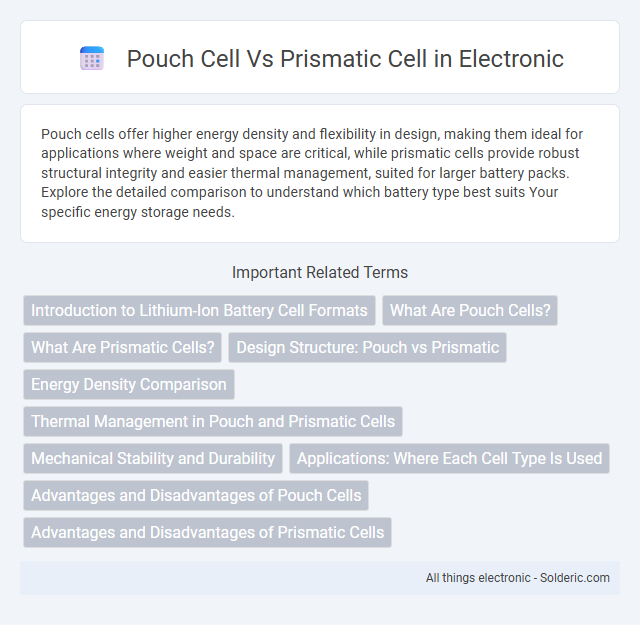Pouch cells offer higher energy density and flexibility in design, making them ideal for applications where weight and space are critical, while prismatic cells provide robust structural integrity and easier thermal management, suited for larger battery packs. Explore the detailed comparison to understand which battery type best suits Your specific energy storage needs.
Comparison Table
| Feature | Pouch Cell | Prismatic Cell |
|---|---|---|
| Shape | Thin, flexible, rectangular pouch | Rigid rectangular metal casing |
| Energy Density | High volumetric and gravimetric energy density | Moderate energy density |
| Weight | Lighter due to flexible packaging | Heavier because of metal housing |
| Thermal Management | Better heat dissipation, easier cooling | More challenging heat dissipation |
| Mechanical Stability | Less robust, susceptible to swelling and damage | Stronger and more durable casing |
| Cost | Lower manufacturing cost | Higher cost due to casing and assembly |
| Applications | Electric vehicles, consumer electronics | Automotive, industrial applications |
| Cycling Performance | Good cycle life with proper management | Consistent cycle life and reliability |
Introduction to Lithium-Ion Battery Cell Formats
Lithium-ion battery cells primarily come in pouch and prismatic formats, each designed to balance energy density, manufacturing flexibility, and thermal management. Pouch cells feature a flexible, lightweight packaging which allows for higher energy density and adaptable shapes but require robust casing solutions to prevent swelling. Prismatic cells use rigid metal casings, offering structural strength and enhanced safety but typically result in lower energy density due to their fixed form factor.
What Are Pouch Cells?
Pouch cells are lithium-ion batteries enclosed in a flexible, heat-sealable foil pouch that allows for lightweight and compact design, making them ideal for applications requiring high energy density and space efficiency. The pouch's flexible packaging enables more adaptable shapes compared to rigid prismatic cells, improving battery pack customization and thermal management. These cells often provide better energy-to-weight ratios, crucial for portable electronics and electric vehicles demanding optimized power-to-weight performance.
What Are Prismatic Cells?
Prismatic cells are lithium-ion batteries encased in a rectangular, rigid metal or plastic housing that maximizes space efficiency and allows for better thermal management compared to cylindrical cells. Their compact design offers higher energy density and easier stacking, making them ideal for electric vehicles and portable electronics. You can benefit from prismatic cells' robust structure, which supports enhanced durability and optimized packaging in modern battery applications.
Design Structure: Pouch vs Prismatic
Pouch cells feature a flexible, lightweight foil pouch that allows for higher energy density and customizable shapes, making them ideal for compact designs. Prismatic cells have a rigid, rectangular metal casing that offers better structural stability and easier stacking, enhancing thermal management. Your choice between pouch and prismatic cell designs influences the battery's size, weight, and durability based on application needs.
Energy Density Comparison
Pouch cells typically offer higher energy density compared to prismatic cells due to their flexible packaging, allowing for more efficient use of space and lighter weight. Prismatic cells provide a more rigid structure, which can result in lower volumetric energy density but improved durability and easier integration into certain battery packs. You should consider pouch cells when maximizing energy density is crucial for compact applications, while prismatic cells may be better for scenarios prioritizing structural integrity and longevity.
Thermal Management in Pouch and Prismatic Cells
Pouch cells offer superior thermal management due to their thin, flat design, allowing for more efficient heat dissipation and uniform temperature distribution across the battery surface. Prismatic cells, with their rigid metal casing, provide robust structural integrity but often face challenges in heat dissipation, requiring advanced cooling systems to prevent hotspots and maintain optimal performance. Your choice between pouch and prismatic cells can impact battery lifespan and safety, especially in applications with high thermal demands.
Mechanical Stability and Durability
Pouch cells offer lightweight and flexible designs but are more prone to swelling and mechanical deformation under stress compared to prismatic cells, which provide enhanced mechanical stability due to their rigid metal casing. Prismatic cells maintain structural integrity better in high-vibration or impact environments, resulting in superior durability for long-term use. Your choice between pouch and prismatic cells should consider the specific mechanical demands of your application to ensure optimal battery performance and lifespan.
Applications: Where Each Cell Type Is Used
Pouch cells are commonly used in portable electronics and electric vehicles due to their lightweight, flexible form factor, and high energy density, making them ideal for applications requiring compact and customizable battery designs. Prismatic cells are preferred in applications such as energy storage systems and electric buses, where robust structure, better thermal management, and easier stacking are critical for durability and long-term performance. Understanding the specific needs of your device or system helps determine whether pouch or prismatic cells provide the best balance of size, weight, and reliability for optimal battery performance.
Advantages and Disadvantages of Pouch Cells
Pouch cells offer high energy density and flexible design, enabling lightweight and compact battery packs ideal for electric vehicles and portable electronics. They provide excellent thermal performance but are more susceptible to swelling and mechanical damage due to their soft packaging, requiring careful cell management. You benefit from faster production cycles and easier scalability, though the need for robust packaging solutions can increase overall costs.
Advantages and Disadvantages of Prismatic Cells
Prismatic cells offer high energy density and better space utilization due to their rigid rectangular shape, making them ideal for applications with limited space such as electric vehicles and portable electronics. Their robust casing provides enhanced mechanical strength and improved thermal management, reducing the risk of swelling and improving safety compared to pouch cells. However, prismatic cells generally have lower manufacturing flexibility, higher cost, and can experience uneven current distribution, which may affect long-term performance and cycling stability.
Pouch cell vs prismatic cell Infographic

 solderic.com
solderic.com